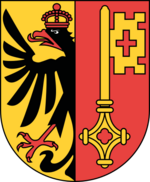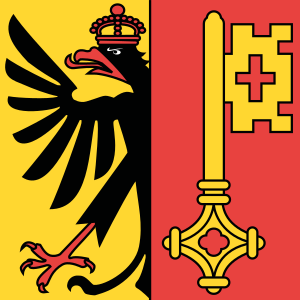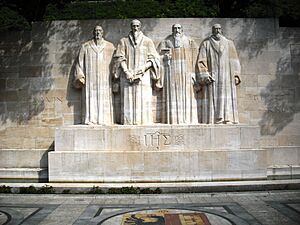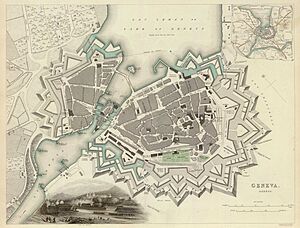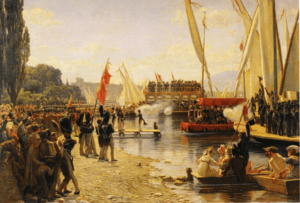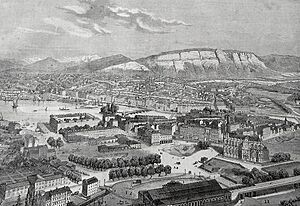History of Geneva facts for kids
The history of Geneva is a long and interesting story that started even before the Romans arrived over 2,000 years ago. Today, Geneva is a major French-speaking city in Switzerland. For many centuries, from the Middle Ages until the late 1700s, Geneva was its own independent city-state. A famous Protestant leader named John Calvin played a very important role in the city during the 1500s.
Contents
Ancient Times and Early Middle Ages
Geneva first appears in history as a border town for the Allobroges people. It was a fort against the Celtic Helvetii tribe. The Roman Republic took control of Geneva in 121 BC.
In 58 BC, Julius Caesar, a Roman governor, destroyed the bridge over the Rhône River at Geneva. He built a long earth wall to stop the Helvetii tribe from moving through the area. Caesar then helped Geneva grow into an important Roman city.
Later, in 443 AD, the Burgundians took over Geneva. Then, in 534, the Franks conquered it. In 888, Geneva became part of the new Kingdom of Burgundy. Finally, in 1033, the German Emperor took control of the town.
In 563 AD, a huge wave, like a tsunami, swept across Lake Geneva. It destroyed many towns and caused many deaths in Geneva. This event, called the Tauredunum event, was likely caused by a massive landslide where the Rhône River flows into the lake. Simulations show the wave could have been eight meters high when it reached Geneva.
Early Christian Leaders
Geneva became a city with its own bishop in the 300s. A bishop is a high-ranking church leader.
The first known bishop of Geneva was Isaac, around 400 AD. Later, in 440, Salonius became bishop. He was the son of another important church leader. Salonius took part in several church meetings during his time. Other bishops followed, including Theoplastus around 475, and Dormitianus before 500. Dormitianus saw the remains of a martyr, St. Victor, brought to Geneva. A church was built in his honor.
High and Late Middle Ages
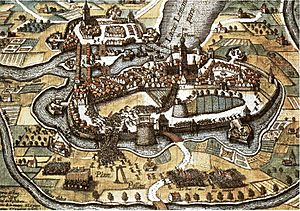
From early on, the bishop of Geneva was under the authority of the Archbishop of Vienne. By 1154, the bishops of Geneva gained the status of prince of the Holy Roman Empire. However, they had to fight hard to keep their independence from the counts of Geneva and later the counts of the House of Savoy. Around 1219, the Counts of Geneva left the city completely and moved their main city to Annecy.
In 1387, Bishop Adhémar Fabry gave Geneva its "great charter." This document was the foundation of the city's self-government. Every new bishop was expected to confirm it. The line of the counts of Geneva ended in 1394. The House of Savoy then took control of their lands. After 1416, they even called themselves Dukes. The Savoy family wanted to control Geneva. They tried to do this by making their own family members bishops. In 1447, Antipope Felix V, who was also the Duke of Savoy, appointed himself bishop of Geneva. The Savoy family ruled the bishop's position until 1490. At that time, the people of Geneva pressured them to give up the title of bishop.
In 1457, a major government group was created in Geneva. It was called the Grand Council. It started with 50 members and later grew to 200. Members were elected every February. The Grand Council represented the citizens of Geneva. It made political decisions and also elected the bishops after the Savoy family gave up that role. This council slowly grew apart from the Duke of Savoy.
Conflicts with the Duke of Savoy
A new problem between the Grand Council and the Duke of Savoy began in 1513. Charles III decided to appoint his cousin, John of Savoy, as bishop. The Pope even agreed to this. However, the new Savoy bishop usually lived in Pignerol, far from Geneva. This made the people of Geneva feel even more distant from the Savoy family.
In 1519, the Grand Council of Geneva tried to form an alliance with Fribourg. But the Duke of Savoy responded by invading Geneva. This led to the execution of Philibert Berthelier, a Geneva patriot. The Grand Council's powers were also suspended. However, after this, Savoy's power over Geneva slowly weakened. In 1521, John of Savoy died. The Grand Council asked Pope Leo X to appoint the next bishop. The Pope then appointed Pierre de la Baume. The Duke of Savoy also tried to make peace with Geneva. In 1523, he marched into Geneva in a special ceremony. He tried to win over Geneva's merchants by promising them a share in trade with Portugal. But the group in Geneva that wanted independence did not accept these offers.
Another political problem happened in 1524. Geneva's treasurer, Bernard Boulet, supported Savoy rule. The Grand Council accused him of stealing money. He asked Charles III to limit the council's powers again. The Duke responded by taking money and property from council members in Savoy lands.
In January 1525, the council asked the Pope to remove Charles III from the church. The bishop, Pierre de la Baume, did not support them. The Pope also rejected their request. However, Charles III feared another rebellion. In September 1525, he offered a power-sharing deal to the Grand Council. The council approved it. But Charles III was not happy and started another invasion to crush the independence group. This group fled to Fribourg. In December 1525, the Grand Council recognized Charles III as the true ruler of Geneva. However, the independence group secretly worked to gain support. In February 1526, they got the support of Bishop Pierre de la Baume. Elections for the Grand Council that month resulted in a pro-independence majority. They voted to break away from Savoy rule. The Grand Council succeeded in protecting its citizens' freedom. They formed an alliance with the Old Swiss Confederacy on February 20, 1526. Representatives from other Swiss regions came to Geneva on March 12. They promised to protect Geneva as part of their confederation.
The Reformation in Geneva
Geneva became a major center of the Protestant Reformation. This was a big religious movement in the 1500s. While Bern supported the new Protestant teachings, Catholic Fribourg ended its alliance with Geneva in 1533.
How the Reformation Started
In 1523, the first Protestants, who were refugees from France, arrived in Geneva. The new Protestant ideas quickly became popular. The power of the Catholic Church in Geneva weakened further after a failed rebellion in 1526. This rebellion was by priests protesting the alliance with Bern and Fribourg. In July 1527, all Catholic priests from noble families were expelled from Geneva. This was because they supported Savoy. The bishop fled Geneva in August 1527 to avoid being captured. He still officially remained the bishop of Geneva. The bishop supported Geneva's independence for a while. But later, he secretly worked with Charles III to cancel the 1526 alliance treaty. Because of this, the Grand Council decided in January 1528 to follow the Lutheran faith. The Pope responded by removing the people of Geneva from the church. Even though Geneva was still officially under a Catholic bishop, the Grand Council used his absence to slowly change worship practices to be more like Lutheranism.
After the 1526 alliance, Charles III of Savoy still wanted to take Geneva. He constantly planned to capture the city again. The fear of Swiss help kept him from a full invasion. But he encouraged small acts of violence against Geneva, like robberies. The bishop of Geneva, who no longer lived in the city, also helped plan to overthrow Geneva's independence. Some knights who wanted to capture Geneva for Charles III formed a group called the Order of the Spoon. These knights tried to invade Geneva by climbing the city wall with ladders on March 25, 1529. This event became known as the "day of the ladders." The Duke of Savoy also tried to convince other Swiss regions to end their alliance with Geneva. He got support from Francis I of France and Emperor Charles V. Emperor Charles V tried to convince the Grand Council of Geneva to return to the Catholic Church. He even wrote a letter in his own handwriting on July 16, 1529. But the council of Geneva refused. Charles V then decided to use force. The Swiss Federation was worried. In May 1530, a group from Bern, Fribourg, Zurich, Basel, and Solothurn suggested that Geneva cancel the 1526 alliance. They offered looser cooperation instead. The Grand Council rejected this offer. They decided to oppose any attempt to bring Geneva back under Savoy rule.
On June 24, 1530, the Grand Council arrested a public prosecutor named Mandolia. He supported Duke Charles III. This angered Bishop Baume, who responded by arresting Genevan merchants in Gex, where he now lived. He also made a deal with the Knights of the Spoon. On August 20, he issued a church order telling them to wage war to return Geneva to its rightful rulers. The attack began on September 30. The Knights of the Spoon joined forces with Charles III's army, totaling about 800 soldiers. The Genevan army had only about 600 men. But on October 10, about 10,000 reinforcements arrived from Bern and Fribourg. Also, Emperor Charles V, even though he supported Savoy, refused to join the war. The invading army was forced to leave. After the Savoy army left, Geneva and Bishop Baume made a peace treaty. The Grand Council in Geneva released Mandolia from prison. The bishop released the Genevans arrested at Gex.
During the Second War of Kappel in October 1531, Geneva was divided politically. Bern asked for military help for the Protestants of Zurich. Fribourg asked for help for the Catholic side. The Grand Council of Geneva was torn between the two. They decided to split their forces and help both sides at the same time. After Zurich's defeat in the war, Fribourg ended its alliance with Geneva. As a result, Charles III of Savoy renewed his plans to capture Geneva. This worried the governments of Bern and Fribourg. They suggested that Geneva cancel the 1526 alliance and accept Savoy rule. The council of Geneva rejected this.
In June 1532, fights broke out in the streets between Catholics and Protestants. The government of Fribourg threatened to end its alliance with Geneva if Protestant practices were allowed. However, the government of Bern pressured the Grand Council of Geneva to allow Protestant preaching. The authority of the Catholic bishop was no longer recognized by the people of Geneva. But at first, they did not want to fully commit their city to the Protestant cause. They feared angering Catholic rulers in nearby kingdoms and the Catholic priests within Geneva.
A Middle Ground for Religions
Catholic priests and monks in Geneva were still a strong social force. They used their influence to try and get the Protestant preachers expelled. On March 28, 1533, they even tried to get Catholic crowds to attack Protestants. This plan failed because of strong city unity and the Grand Council's efforts to keep the peace. The Grand Council was careful in its decisions. It tried to find a middle path between the two groups. As part of this, in March 1533, it allowed the Bible to be published in French. But it was a traditional translation that both Protestants and Catholics could accept. The Grand Council also needed to stay allied with both Catholic and Protestant regions. In February 1533, Fribourg openly ended the 1526 alliance treaty. Later, it even planned to invade Geneva.
To keep peace between Catholics and Protestants, and to stay neutral between Catholic and Protestant powers, the Grand Council of Geneva passed a compromise law on March 30, 1533. This law allowed every Genevan to choose their religion. But it banned open attacks on Catholic beliefs and practices. It also banned all religious preaching in public places for both sides. Eating meat on Fridays was forbidden for everyone. However, neither side truly intended to follow the law. Street fights broke out from time to time.
Protestantism Wins Out
Even after Bishop la Baume was forced out of Geneva, Protestantism was not guaranteed to win. The Catholic group in the city secretly worked with Fribourg to bring the Catholic bishop back to Geneva. La Baume was hesitant at first, but Pope Clement VII pressured him to agree. On July 3, 1533, with military help from Fribourg, the bishop entered Geneva again in a parade. The Grand Council demanded that the bishop respect the city's traditional freedoms. He promised to do so. However, the bishop soon started arresting important Protestants in Geneva. There were rumors that he planned to move the prisoners to Fribourg, where the Grand Council could not reach them. On July 12, riots broke out. The bishop gave in to the public outcry and handed the prisoners over to the Council. Fearing for his life, the bishop decided to flee the city. He left on July 14, this time never to return. He moved his main office to Arbois and later to Chambery. However, de la Baume officially remained the bishop of Geneva. Catholic priests and monks were still a strong group in the city. The bishop still tried to control Geneva. On October 24, 1533, he wrote a letter to the council, demanding that they stop Protestant preaching in Geneva. The council refused.
After the bishop fled, the influence of Protestant preachers in Geneva grew. This happened despite the local Catholic priests' anger. Bern pressured Geneva, threatening to cancel the 1526 alliance treaty unless Protestants were given freedom. Also, the exiled bishop slowly lost popularity even with Catholic Genevans. This was because he often tried to interfere with the city's legal matters from afar. Genevans saw this as attacks on their city's freedoms. As a result, in January 1534, the Grand Council agreed to allow church leaders to be tried by city authorities. Catholic influence in Geneva lessened even more after some Catholics left the city on July 30, 1534. This was due to growing tensions between Catholics and Protestants. In the February 1535 election for the Grand Council, Protestants gained a majority. Bishop de la Baume, seeing Geneva becoming Protestant, issued a rule on June 13, 1535. It banned trade with Geneva, threatening to remove from the church anyone who traded with them. The Grand Council, even with a Protestant majority, still did not declare the city Protestant. They feared attacks from Catholic kingdoms nearby. To force the council to act, Protestant leaders like Guillaume Farel began urging crowds to destroy religious statues and throw communion wafers to the ground in Catholic churches. As a compromise, the Grand Council decided on August 10, 1535, to ban the breaking of statues. But they also banned the celebration of Mass. This led to even more Catholics leaving the city for Savoy lands. After another failed invasion of Geneva by Savoy forces in October 1535, which ended in a Savoy defeat, the Grand Council decided on February 3, 1536, to destroy all castles around Geneva. This was to prevent any princes from having an excuse to invade their city again.
On May 21, 1536, the people of Geneva declared themselves Protestant. All residents took a public oath to the Lutheran faith. They also declared their city a republic. This decision had been planned for a long time. But it was delayed due to fears of a Savoy invasion. However, a French invasion of Savoy lands earlier that year removed that threat.
The Protestant leader John Calvin lived in Geneva from 1536 until his death in 1564. He became the spiritual leader of the city. This position was created by the Grand Council after the city became Protestant. Geneva became a hub of Protestant activity. Works like the Genevan Psalter were created there. However, there were often disagreements between Calvin and the city's government. Calvin also supported allowing Protestant refugees into Geneva, which some groups strongly opposed.
Even though the city itself remained a Protestant stronghold, much of the historic diocese returned to Catholicism in the early 1600s. This happened under St. Francis de Sales. Geneva has played a major role in spreading Protestantism.
In addition to becoming a Protestant state, Geneva also became a kind of welfare state in the 1500s. A general state hospital was set up in 1535 by a wealthy Protestant named Claude Salomon. A central education system was also created with the help of John Calvin.
In 1584, Geneva strengthened its ties to the Swiss Confederacy. It made a special "eternal treaty" with the Protestant cities of Bern and Zürich. But the five Catholic regions blocked any suggestions for Geneva to fully join the Confederacy.
17th Century
In the 1580s, problems with Savoy grew worse again after Charles Emmanuel I became duke. On the night of December 11, 1602, in an event known as L'Escalade, the Savoyards tried to capture the city by surprise. They climbed over the walls using dark ladders. But they were discovered and fought off.
Geneva became more aristocratic during the 1600s. This meant it became very hard for outsiders to become citizens. The main assembly of citizens, the Conseil général, lost almost all its power. Power shifted to smaller councils, like the Petit Conseil and the Conseil des Deux-Cents. These councils were filled with members of powerful families through unfair appointments. Society was divided into different groups:
- Citoyens: These were members of old powerful families or children of Bourgeois born in Geneva. They had full citizenship.
- Bourgeois: These were citizens who had been naturalized (given citizenship) or children of Bourgeois not born in the city.
- Natifs: These were people born in Geneva but whose parents were not citizens.
- Habitants: These were non-citizens allowed to live in Geneva for a fee.
- Sujets: These were people living in nearby villages controlled by Geneva.
18th Century
Throughout the 1700s, Geneva faced conflicts between its French-speaking wealthy families and radical groups who wanted more power for the common people. The wealthy families controlled the city's councils. They used their power to raise indirect taxes, which hurt the poor more than the rich. They were accused of being too pro-French and not loyal to the republic or to Calvinism. The opposition groups, however, followed strict Calvinism and believed in a republic where the people had more power.
Conflicts between these groups led to riots from 1734 to 1737. These were settled after France and Geneva's Swiss allies, Bern and Zurich, stepped in to help. In the 1750s, the opposition, led by watchmaker Jacques François Deluc, started calling themselves the représentants (representatives). They wanted the General Council, Geneva's main law-making body, to truly represent the people. They also wanted it to regain power over the aristocratic ministers on the Council of Twenty-Five, which was the executive council. This did not happen. But more unrest in 1767 led to another agreement between the wealthy and the common people, arranged by France.
Meanwhile, a debate among French-speaking thinkers made the unrest even worse. In 1757, a piece by Jean le Rond d'Alembert appeared in a famous encyclopedia. It criticized Geneva's Calvinist pastors for being too strict. It suggested that Geneva adopt more enlightened arts, like in France. Jean Jacques Rousseau disagreed with d'Alembert and other thinkers. He argued for stricter morals and sided with the radical groups, though he did not fully support democracy.
Finally, in the failed Geneva Revolution of 1782, revolutionary thinkers and working-class activists demanded more voting rights. They took control of the state. Popular representatives were elected to a committee that began making big changes. However, France, Bern, and Savoy sent a military force to Geneva. This caused the leading revolutionaries to flee to nearby Neuchâtel. They said they would create a new Geneva elsewhere with other hardworking citizens. The invading forces imposed a new constitution on Geneva that strengthened the power of the wealthy families. This led many Genevans to leave and try to build a new Geneva in places like Waterford, Cologne, or Brussels. Many of these radical exiles went on to achieve great things, including taking part in the French Revolution (1789–1799).
During the French Revolution period, the wealthy and democratic groups again fought for control of Geneva. In 1798, however, France, then under its Directory government, took over Geneva and its surrounding area.
19th Century
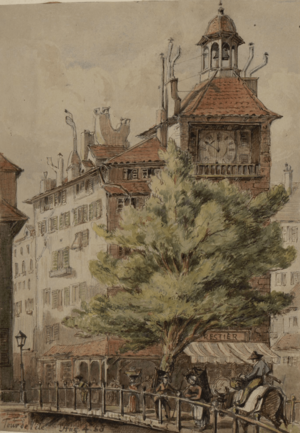
In 1802, Geneva's church district was joined with that of Chambéry. When Napoleon's armies were defeated and Geneva was freed in 1813, it regained its independence. At the Congress of Vienna in 1814–15, Geneva's territory grew. It gained 15 areas from Savoy and six from France, adding over 16,000 Catholics. At the same time, Geneva was allowed to join the Swiss Confederation. The Congress specifically stated that in these new territories, the Catholic religion would be protected. No changes could be made without the Pope's approval. The Congress also guaranteed Geneva's neutrality. Pius VII in 1819 joined the city of Geneva and 20 parishes with the Diocese of Lausanne. The rest of the old Diocese of Geneva (outside Switzerland) was reformed in 1822 as the French Diocese of Annecy.
The Great Council of Geneva (the local government) later ignored these promises. It insisted on approving all papal documents before they could be published. Catholics were very angry about civil actions taken against Marilley, a priest who later became bishop. They were also upset about the Kulturkampf, which forced them to pay taxes to support the Protestant Church and the Old Catholic Church, without getting any public help for Catholicism.
20th Century
On June 30, 1907, with strong Catholic support, Geneva decided to separate church and state. The Protestant faith received a one-time payment of 800,000 Swiss francs as compensation. Other faiths received nothing. Since then, the Canton of Geneva has not given financial aid to any religion from state or city funds.
Geneva's international importance grew after World War I. In 1919, Geneva became the home of the League of Nations. This happened thanks to people like Gustave Ador and Swiss diplomat William Rappard. Rappard also helped found the Graduate Institute of International and Development Studies, Europe's oldest graduate school for international studies. Also, the International School of Geneva, the oldest international school still operating, was founded in 1924 by senior members of the League of Nations and the International Labor Office.
After the war, a class struggle grew in Switzerland. It led to a general strike across the country, starting on November 11, 1918. This strike was mainly led from the German-speaking part of the nation. However, Geneva's friendly feelings toward France lessened its impact on the city.
On November 9, 1932, several small Fascist-inspired political groups attacked Socialist leaders. This led to a later protest by the Left against the Fascists. During this event, young recruits in the Swiss Army fired into a crowd without warning. This resulted in thirteen people losing their lives and 63 being injured. As a result, a new general strike was called a few days later in protest.
After World War II, the European headquarters of the United Nations and many international organizations moved to Geneva. This led to more tourism and business in the city.
In the 1960s, Geneva became one of the first parts of Switzerland where rights movements had some success. It was the third region to grant women the right to vote at the local and regional levels.
Images for kids
See Also
- Timeline of Geneva
- Bourgeois of Geneva
- Calvin Auditory, a chapel in Geneva important in the Reformation
- Lausanne and Geneva bishopric(s)


